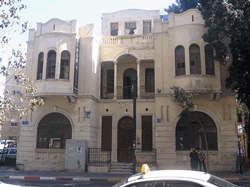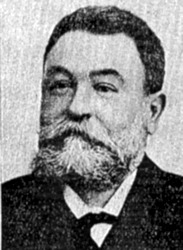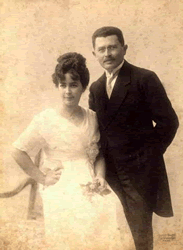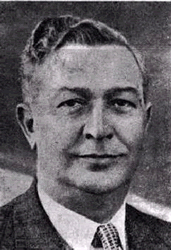LITVINSKY
|
The Litvinsky home in Tel Aviv |
Yaakov Elchanan Litvinski |
Moshe morris with wife Baki Litvinski |
Yaakov Elchanan Litvinsky (Odessa, 1852 - Tel Aviv, October 12, 1915) was a Zionist merchant and activist, a member of Brith and one of the founders of Tel Aviv. He was born in Odessa, Ukraine (then in the Russian Empire) in 1852 to his father Moshe Halevi. He studied both traditional Jewish education and general education. When an adult and married to his first wife he was one of the first to join the Zionists' Association in his city. In 1880 he was widowed, He liquidated his business and immigrated to Eretz Israel.
Upon his immigration, he settled in Jaffa and married Belinda (Sarah Bila) Finkelstein (daughter of the chairman of the Jewish community in Bordeaux, Arie Leib Finkelstein). He tried to build a flour mill in Gaza, but failed, returned to Jaffa, and established a soap factory. In Rishon Lezion but did not succeed as a farmer and returned to Jaffa. He also purchased land in the Sharon on which the Gaash and Shefayim kibbutzim were later established.
In 1909 he joined the Ahuzat Beit Association towards the founding of Tel Aviv, and became the oldest founder of the new city. In the lottery, he won a lot on 22 Ehad Ha'am Street, on which he built a house of virtue, one of the largest and most magnificent in Little Tel Aviv. The Masonic Bureau "Barkai" operated in his house and the house he built was full of symbols of the Masons .
Litvinsky died on the 4th of Cheshvan 1906, and was buried in Trumpeldor Cemetery.
His sons, Morris (Moshe), Emil (Emanuel) and Raymond left the Land of Israel for Egypt during the deportation of Jaffa (1914), where they met Baron Felix de Menashe, through whom he engaged in trade and even suppliers to the British army. With the return of Morris and Emil to Israel at the end of World War I (Raymond traveled to France), they purchased land in the Sharon and Tel Aviv, including 1,700 dunams of land in the village of Skia on which the Tel Litvinsky complex (Tel Hashomer) was established, where they intended to establish a city named after their father.
Raymond, the youngest of the boys, lived as a bachelor in Paris and died in 1956. Morris died in 1952 and Emil died in 1962.
A small street next to Mendes Vogilgassadiim streets in Tel Hashomer, today Ramat Gan, is the last remnant of the city of gardens that was to be built on the outskirts of Tel Aviv. All that is left of that dream is the sign of the small street, which reads: "Litvinsky Brothers Street, the founders of Tel Litvinsky, Tel Hashomer and Halutzia."
The Dutch street and over 40 wonderful fig trees planted along it and on both sides are the same age as the retirees' elected officials, as are the two dozen houses. The whole area around, Tel Hashomer Hospital, an absorption and sorting base named after the first Chief of Staff Yaakov Dori, the IDF Archives, the Kiryat Krinitzi neighborhood, the Cypress Avenue, and also the areas that still remain virgin, were supposed to be littered with villas, only villas, with Schools, sports facilities, cinemas and theater.
It was World War II that disrupted all plans and ruined the dreams. Most of the lands of the city of the future were expropriated by the British, and Tel Litvinsky, the city that was supposed to bear the name of the father of the family, the tycoon Yaakov Elchanan Litvinsky, remained in the outline files. The name of the place was changed to Tel Hashomer, to commemorate the first guard organization that operated in the Land of Israel, and today it is mainly a military complex and a hospital.
The Litvinsky family stuck a stake in Israel in 1886, even before Herzl broke with his vision. Yaakov Elchanan Litvinsky, who immigrated from Odessa, purchased land from the following near: 40 dunams in Rishon Lezion (his attempt to be a farmer was unsuccessful); Land in Gaza, where he set up a steam-powered flour mill; Soap production plant in Jaffa; Lands in the Sharon, in the area
Where volcanoes and ridges were later established; Litvinsky was also one of the founders of Tel Aviv, the oldest and richest among them, and lived at 22 Ehad Ha'am Street, one of the first houses in the city. He is also one of the founders of Union Bank.
In 1916, in the midst of World War I, Litvinsky passed away and the huge legacy passed to his three sons. The youngest son, Raymond, moved to Paris. Morris and Emil continued in their father's footsteps and even empowered his property. The rest of their flesh, Aviezer Shloshe, wrote in his book that during World War II they moved to Egypt, engaged in trade and supplied most of the needs of the British army in the Middle East.
At the end of the war, the brothers returned to Israel as agents of the British fuel company "Shel" and a contractor company to build stores in Jaffa. Emil specialized in purchasing land, including 1,700 dunams east of Jaffa, the area on which a garden city was to be built. Architect Kaufman promised homes plenty of sunshine and light and demanded to maintain the architectural style. For a limited number of buyers allowed to build their own homes.The area of the city is divided into two thousand plots, some of which are intended for use as summer houses, restaurants, boarding houses, hotels and also small farms. In the first four years of the Garden City, 24 houses were built, purchased by immigrants from Germany, but these found it difficult to establish their livelihoods. The idea did not gain momentum and in addition the place became a front line during the events of 1936-1939, as the Great Arab Revolt was called which sought to put an end to Jewish settlement in the Land of Israel.
In the end only ten families, most of them from Germany, settled in the place. These were older people, all academics. These families put up only 16 men carrying weapons
And two other women in combat fitness. They had at their disposal one rifle and three sticks.
The small settlement was surrounded by Arab villages - 20,000 residents closed in on it in a half arc to the north and east. At one point, the question arose as to whether to respond to the Arab onslaught or flee to Tel Aviv. "At the same time, the slogan was born ... 'We will not move from here,'" wrote Zeev Natan Teplitzky, one of the buyers of the houses, in a rare testimony. The few residents opted for a security committee with guard shifts, means of obtaining weapons and means of transportation and liaison, including liaison with the Haganah organization and Betar.
Meanwhile, World War II broke out and Litvinsky's Garden City was shrinking on paper as well. The British confiscated 1,200 dunams from the brothers and set up a military camp on them called Tel Litvinsky. By mid-1942, workshops and workshops were established on the expropriated land, as well as a small clinic that served their workers. When the U.S. military in Egypt needed an inpatient facility in the area, the United Kingdom was asked to allocate territory. The British had the main hospital in Sarpand (Zrifin), and thus the Americans were allotted space in Tel Litvinsky. The small clinic was expanded to accommodate 450 beds.n April 15, 1948, when an observer reported that the last British had left the compound, a force from the 33rd Battalion of the Alexandroni Brigade infiltrated it.
From the village of Azar, and at the end of a day of house-to-house fighting, most of the camp was captured. Three fighters fell. The southern part of the camp was captured only two weeks later, in Operation Chametz. Mid-1953. At some point in 1948, the name of the Tel Litvinsky camps was changed to Tel Hashomer.
This was the end of the garden city that today is seen in the area only on that small street, the Litvinsky brothers. Haim Litvinsky, the son of Morris, a retired judge and lawyer, told a researcher at the Ben Or-Dadon Foundation from Bar Ilan University that he had failed in his struggle to restore the entire area to its original name, Tel Litvinsky. The mayor of Ramat Gan, Zvi Bar, ordered to commemorate the family on the street where the houses of the city of gardens stand and also inaugurated a public park in their memory. These, and line 70 in its later version, are the only remnants of a vanished dream.
The Litvinsky brothers' property was scattered all over the country. As far as is known, they had 600 dunams of land in the area of Kibbutz Gaash and Shefayim, 60 dunams in Tel Aviv, some of which was expropriated for the construction of the Habima Hall of Culture and Theater, Beit Hadar area where the "Shel" fuel companies' warehouses were located, 60 dunams in Haifa. Ramat Hadar neighborhood, as well as areas in the area of the train station in Jerusalem and in one of the neighborhoods in Petah Tikva.Each area has its own story and expropriations. The brothers, who were undoubtedly Zionist patriots, were also rivals of the local establishment, for example in the matter of employing Arab workers while the locality was fighting for the rooting of Hebrew labor. Eventually the brothers also parted ways and they and their heirs met only in the courts. The quarrels caused their widowed mother to leave the country and live alone in Geneva.
Raymond, the younger of the brothers, died childless. When his will was opened, it became clear that the main thing
He bequeathed his money to the Hebrew University of Jerusalem, distributing about one million French francs among different people in France, while to each of his family members, his mother, his brother Emil and the sons of his brother Morris - he bequeathed one pound of Eretz Israel.
Emil Litvinski
Nathan Teplitzky also no longer enjoys his home in Tel. During British rule, they paid him two Israeli pounds a month for the expropriated land. When the British evacuated, it became the property of the State of Israel. Ariel Litvinsky, Emil's son, gave Teplitzky a certificate of ownership, but he never got his property back, despite his applications.



